Abstract
The morphology evolution from monoclinic molybdenum trioxide (β-MoO3) to orthorhombic molybdenum trioxide (α-MoO3) and quantitative analyses of their mixtures were examined. It was found that the morphology (from spherical to elliptical shape) and color (from green to white) displayed obvious changes when β-MoO3 converted to α-MoO3 in ambient air at 773 K. The transformation from β-MoO3 to α-MoO3 resulted from a change of the internal crystalline structure. The mass percent of β-MoO3 in MoO3 mixtures showed an excellent linear relationship with the relative intensity ratio of the strongest peaks in X-ray diffraction patterns. This approach provides a simple and time-saving method to evaluate the amount of β-MoO3, which is a promising material in catalyst and electrochemical applications, in such mixtures. This finding may provide guidance for the analysis of catalytic performance of MoO3 mixtures. In addition, it was found that β-MoO3 can be easily decomposed into suboxides such as MoO2 and Mo4O11 in pure argon gas atmosphere. The possible decomposition mechanism of β-MoO3 is discussed.
1 Introduction
Transition metal oxides, such as V2O5, CrO3, WO3, and MoO3, show several types of complex structures, formed mainly by two- or three-dimensional frameworks of octahedral or tetrahedrals [1,2,3]. Among these materials, MoO3 has been recognized as a promising material for a rapidly increasing number of applications such as chemical synthesis, petroleum refining, gas sensor devices, photoluminescence, photochromism, electrochromism, smart windows, catalysis, and display devices [4]. MoO3 has different structures that can be divided into four polymorphs [5,6,7,8,9]: (1) thermally stable orthorhombic phase, α-MoO3; (2) metastable monoclinic phase, β-MoO3; (3) metastable phase at high-pressure conditions, β′-MoO3; and (4) hexagonal phase, h-MoO3. In all these MoO3 structures, the MoO6 octahedron is the primary unit, and its arrangement results in differences in the structures. The two most commonly studied polymorphs are α-MoO3 and β-MoO3; however, β-MoO3 is believed to possess more novel and enhanced properties in catalysis and electrochemical applications when compared with α-MoO3 [10]. It is regrettable that the synthesis of pure β-MoO3 is usually difficult at ambient conditions [11,12], whereas mixtures of α-MoO3 and β-MoO3 are much easier to produce [13,14,15,16]. To make full use of the mixtures of α-MoO3 and β-MoO3 that are usually produced, it is necessary to quantitatively analyze the mixtures and evaluate the amount of β-MoO3, which may be an evaluation index, and to better understand the properties of the mixtures.
X-ray diffraction (XRD) is widely used for the quantitative analysis of geological samples [17,18]. Hillier [19] conducted the accurate quantitative analysis of clay and other minerals in sandstones by XRD using the relative intensity ratio (RIR), which gave accuracy within ±3 mass% at the 95% confidence level. Vaverka and Sakurai [20] investigated the composition of steelmaking slag, and the amount of free lime was determined by the X-ray powder diffraction and the standard addition method. Recently, Shu et al. [21] adopted the quantitative XRD analysis to calculate the ratio of mass percentages of reactant (CaWO4) and product (W) from the intensities of the strongest peaks, from which fractional conversion was calculated, thus enabling the kinetics of reduction of CaWO4 by Si to be successfully described.
Although many methods have been used for quantitative determination of different sample mixtures, XRD is nondestructive, and the samples can be used for other chemical analyses. However, there are no specific reports on the quantitative relationship between α-MoO3 and β-MoO3. In the present study, the quantitative XRD analysis was used to determine the quantitative relationship between α-MoO3 and β-MoO3 and to evaluate the amount of β-MoO3 in mixtures. The morphology evolution from β-MoO3 (spherical) to α-MoO3 and the possible decomposition mechanism of β-MoO3 were also elucidated.
2 Materials and experimental procedures
2.1 Raw materials (β-MoO3)
Pure ultra-fine β-MoO3 (green), prepared by the method of sublimation [22,23], was used. The X-ray diffraction pattern of the sample is shown in Figure 1. The intensity of the strongest peak for this sample was located at 2θ = 23.04° with a reflection of (011). Field-emission scanning electron microscopy (FE-SEM) images of samples at different magnifications are shown in Figure 2. All powders appeared to have a spherical shape and fine crystalline size although their size was nonuniform.
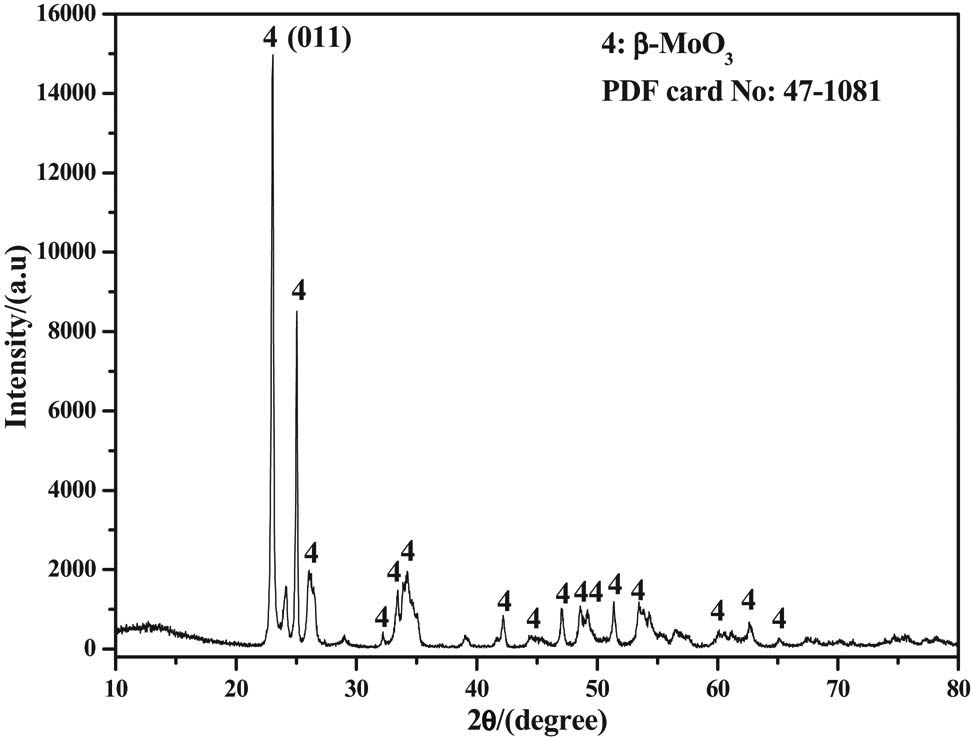
X-ray diffraction pattern of the studied β-MoO3 sample.
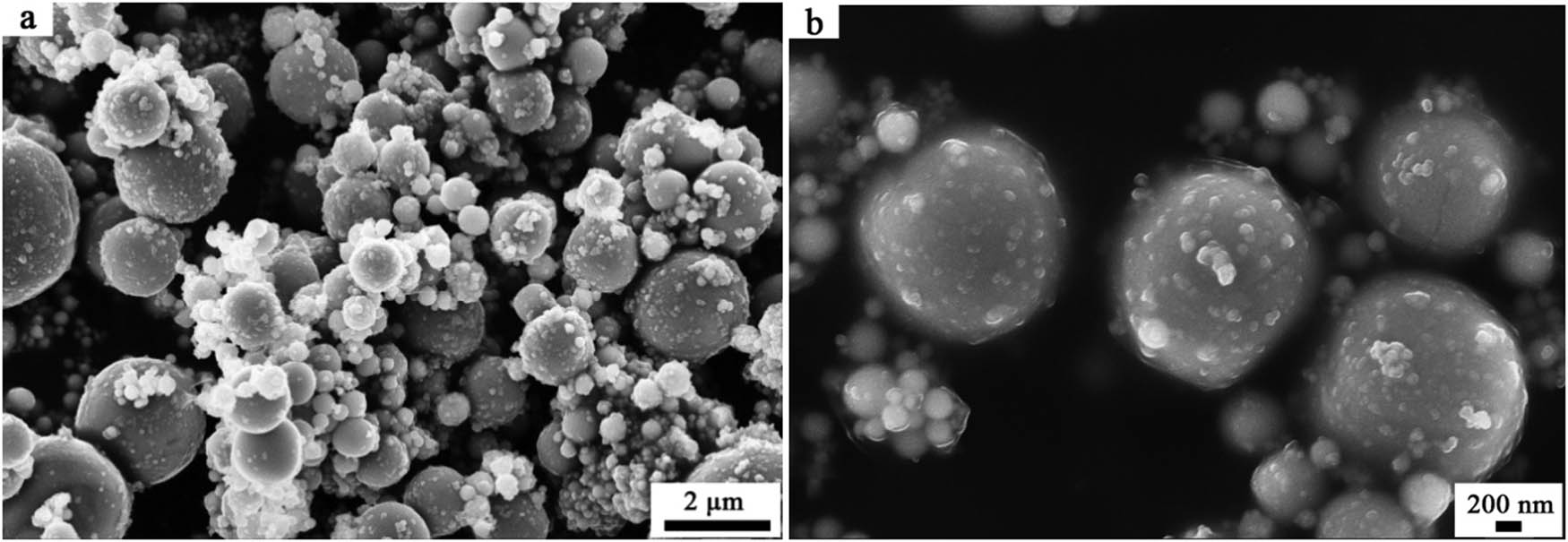
Filed-emission scanning electron micrographs of the studied β-MoO3 sample with different magnifications: (a) 20000 times; (b) 50000 times.
2.2 Preparation of α-MoO3
The transformation temperature from β-MoO3 to α-MoO3 obtained from the previous literature [9,10,15] is around at 673–723 K. Therefore, in the present study, α-MoO3 was prepared by roasting β-MoO3 at 773 K in the air; the higher roasting temperature was used to complete the transformation within a short time and to control the MoO3 vapor. After confirming that the prepared products were all pure α-MoO3, samples were prepared for morphology observation and used to synthesize mixed MoO3 specimens.
2.3 Preparation of mixtures of β-MoO3 and α-MoO3
To identify the quantitative relationship between β-MoO3 and α-MoO3, standard mixtures with a mass ratio (W) of β-MoO3 to the total mass of β-MoO3 and α-MoO3 that varied from 0 to 1 were prepared, i.e.:
where W was in the range of 0–1.
After carefully weighing and mixing β-MoO3 and α-MoO3 based on the specified mass ratio, the mixtures were homogenized for 30 min by milling in an agate mortar and then subjected to the quantitative XRD analysis.
The total mass of mixtures of β-MoO3 and α-MoO3 was fixed at 500 mg. The morphologies of β-MoO3 and α-MoO3 were observed by FE-SEM (ZEISS SUPRA 55, Oberkochen, Germany). Phase compositions were analyzed by the XRD (Model TTR III, Rigaku Corporation, Japan) using Cu Kα-filtered radiation with a scanning speed of 6°/min and scanning step of 0.02°.
3 Results and discussion
3.1 Crystalline modification and morphology evolution
Figure 3 shows the XRD pattern of the roasted products. It can be seen that pure α-MoO3 can be prepared by roasting β-MoO3 at 773 K in air. In addition, the color was converted from green to white, which demonstrated that the transformation from β-MoO3 to α-MoO3 is photochromic. The intensity of the strongest peak of α-MoO3 was located at 2θ = 27.36° with a reflection of (021). FE-SEM micrographs of the as-prepared α-MoO3 at different magnifications are shown in Figure 4. The morphologies of the as-prepared α-MoO3 no longer maintained the perfect spherical shape of β-MoO3 as shown in Figure 2. Numerous spiral fringes formed around the oval α-MoO3 particles, which led to the formation of a layer structure.
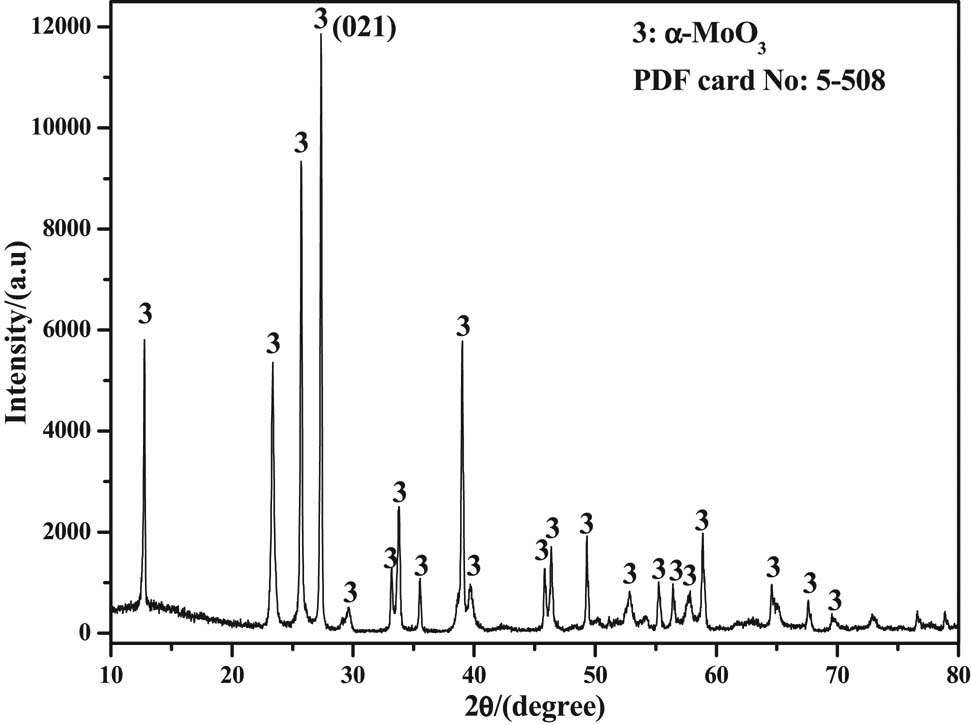
X-ray diffraction pattern of the as-prepared α-MoO3.
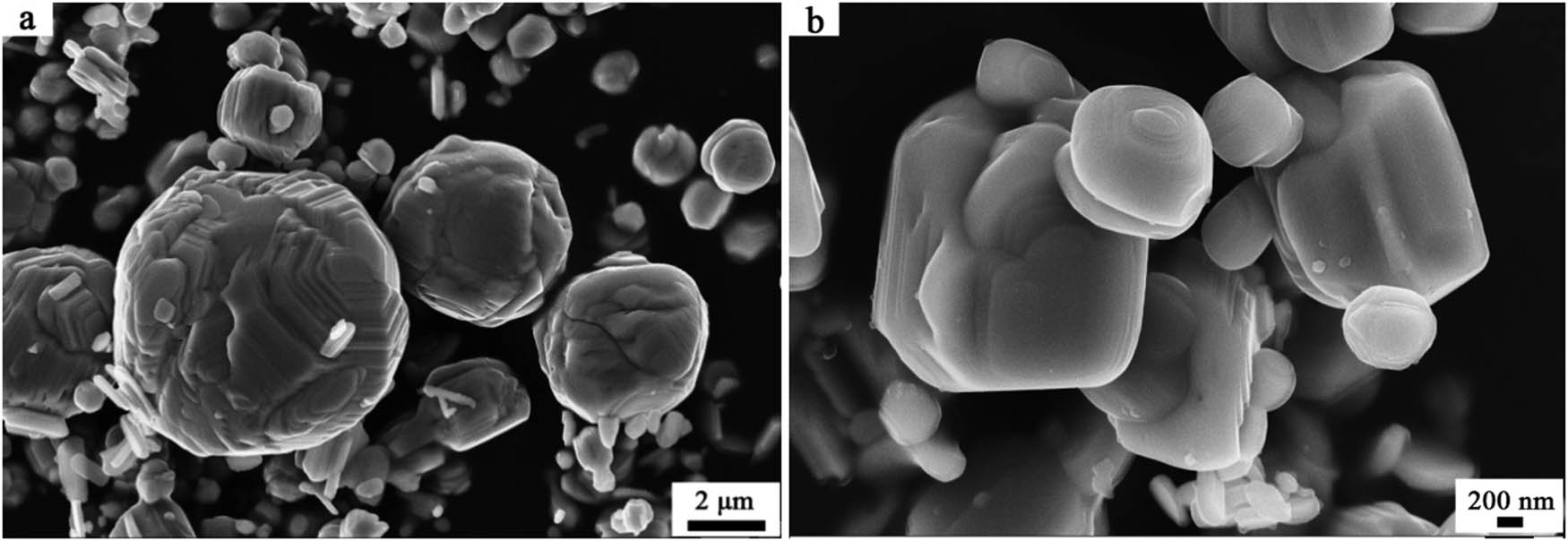
Field-emission scanning electron micrographs of the as-prepared α-MoO3 with different magnifications: (a) 15000 times; (b) 50000 times.
The changes of the morphology and the color on conversion from β-MoO3 to α-MoO3 indicated that the structures of the two phases were different. The crystal structure of β-MoO3 shown in Figure 5 indicated that β-MoO3 has a ReO3-type structure in which the MoO6 octahedrons only share corners with each other; each oxygen atom is shared by two octahedrons. In contrast, the crystal structure of α-MoO3 (α-MoO11O22O33) has a unique two-dimensional layer structure in which each layer is built up of MoO6 octahedrons connected along ac-planes by common edges and corners to form zigzag rows and along ab-planes by common corners only, as shown in Figure 6. The interlayer interaction is weak and bounded in the a-axis direction by van der Waals forces. The transformation from β-MoO3 to α-MoO3 is explained by the metal off-center displacement toward O1 (and a little less toward O2) centers, which is stabilized by an increase in covalence between the Mo and O atoms [24]. When heating β-MoO3 at T = 773 K in air, the crystals mainly grow by coalescence with neighboring crystallites, driven by the heat treatment process, and the crystal has a tendency to form a layer structure, so the morphology of α-MoO3 has many spiral fringes.
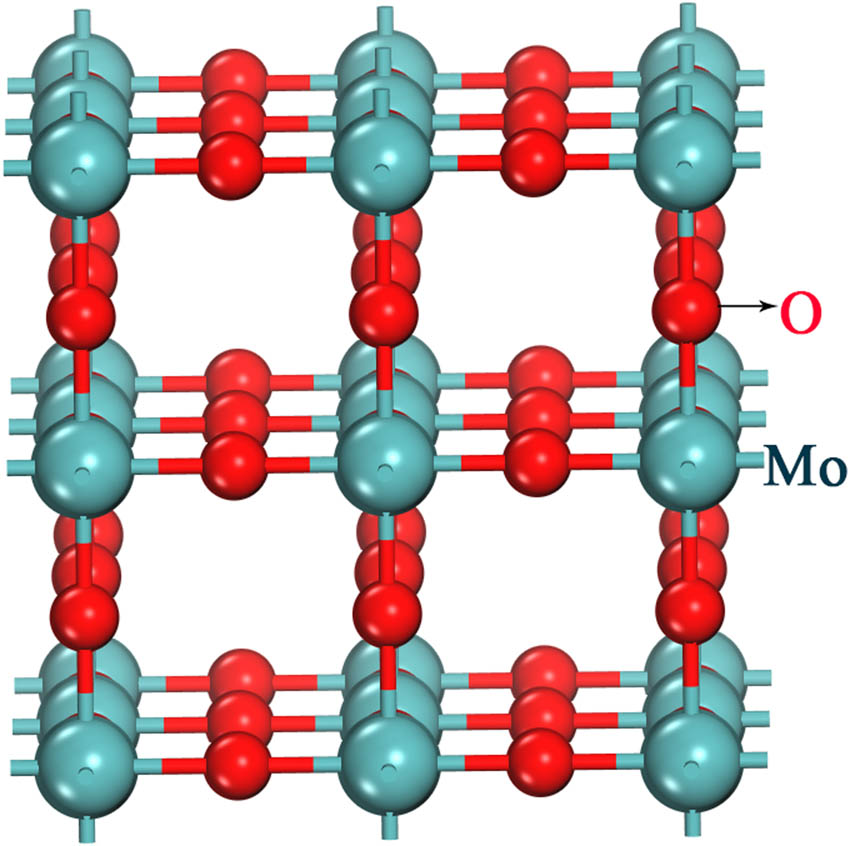
Crystal structure of β-MoO3.
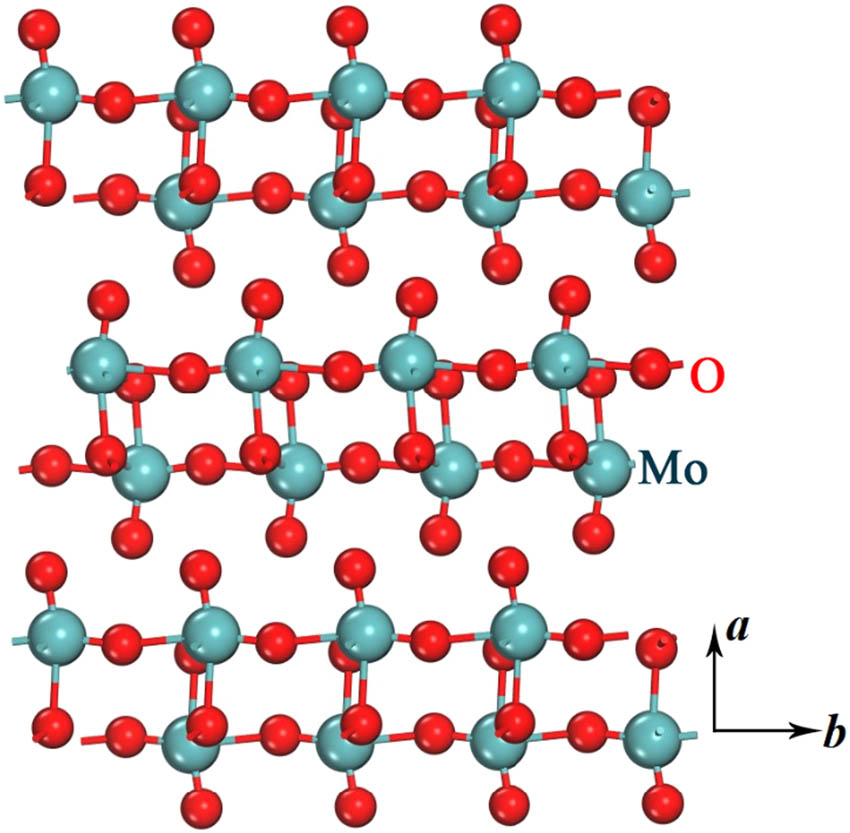
Crystal structure of α-MoO3.
3.2 Determination of quantitative relationship curves
Quantitative curves were determined by using the quantitative X-ray analysis based on RIR values [18]. The ratios of the mass of β-MoO3 to the total mass of β-MoO3 and α-MoO3 were calculated by the intensities of the strongest peaks for β-MoO3 (peak (011)) and α-MoO3 (peak (021)). The XRD patterns of mixtures of β-MoO3 and α-MoO3 at different mass ratios are displayed in Figure 7. The intensity of the strongest peak of β-MoO3 gradually increased and that of α-MoO3 gradually decreased with the increase of mass ratio (W). The intensity changes are listed in Table 1. The values of Iβ/(Iβ + Iα) had a strong linear relationship with W, as shown by the results presented in Figure 8. According to these results, it is easy to obtain the mass percent of β-MoO3 in mixtures of β-MoO3 and α-MoO3.
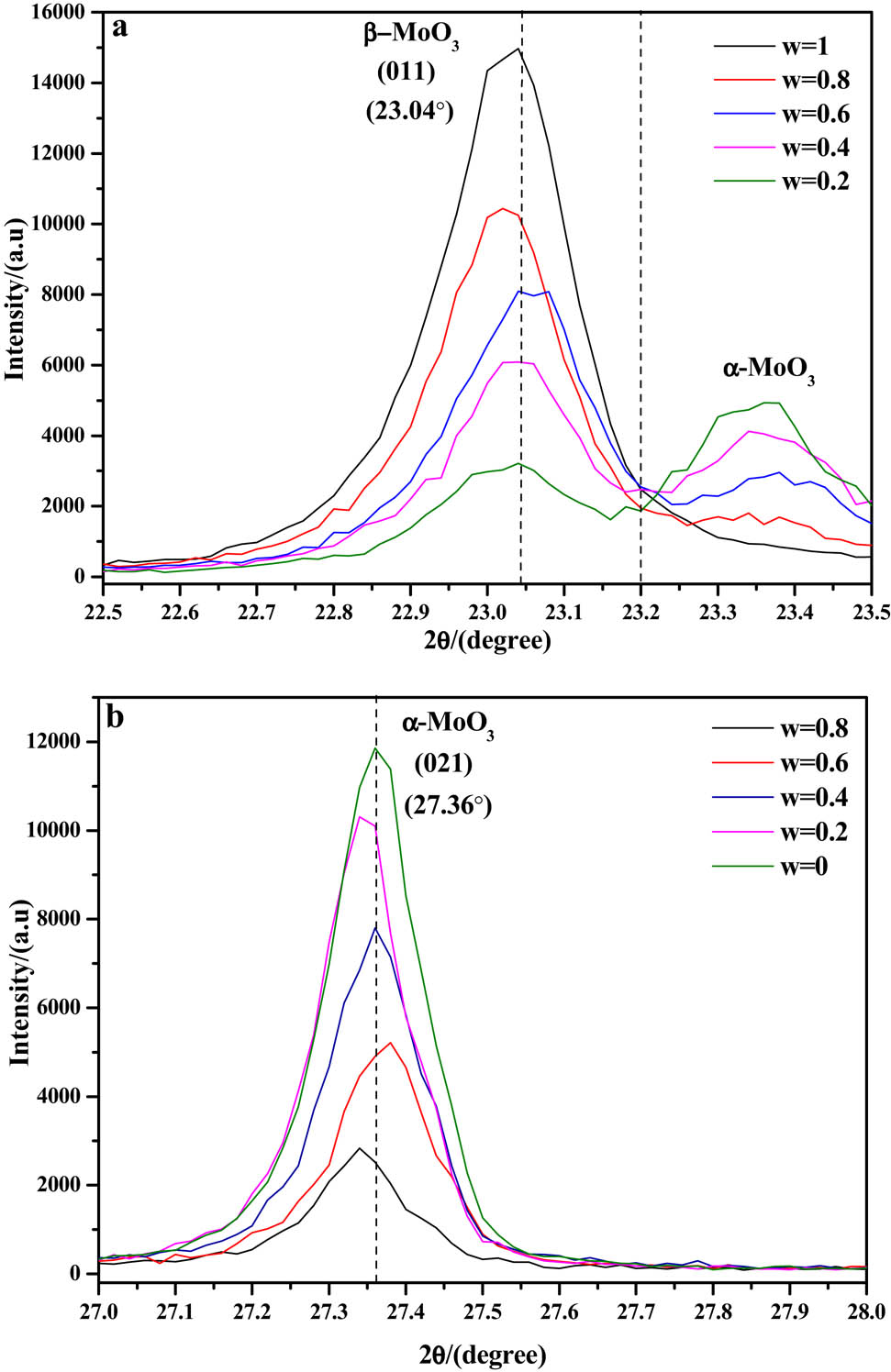
X-ray diffraction patterns of mixtures of β-MoO3 and α-MoO3. (a) Changes of intensity of strongest peaks of β-MoO3 and (b) changes of intensity of strongest peaks of α-MoO3 (W represents the ratio of the mass of β-MoO3 to the total mass of β-MoO3 and α-MoO3).
Changes of intensity of strongest peaks of β-MoO3 and α-MoO3 for different mixture ratios.
| W | 0 | 0.2 | 0.4 | 0.6 | 0.8 | 1 |
|---|---|---|---|---|---|---|
| Iβ/(a.u.) | 0 | 3,215 | 6,090 | 8,095 | 10,435 | 14,970 |
| Iα/(a.u.) | 11,860 | 10,310 | 7,805 | 5,210 | 2,830 | 0 |
| Iβ/(Iβ + Iα) | 0 | 0.2377 | 0.4383 | 0.6084 | 0.7867 | 1 |
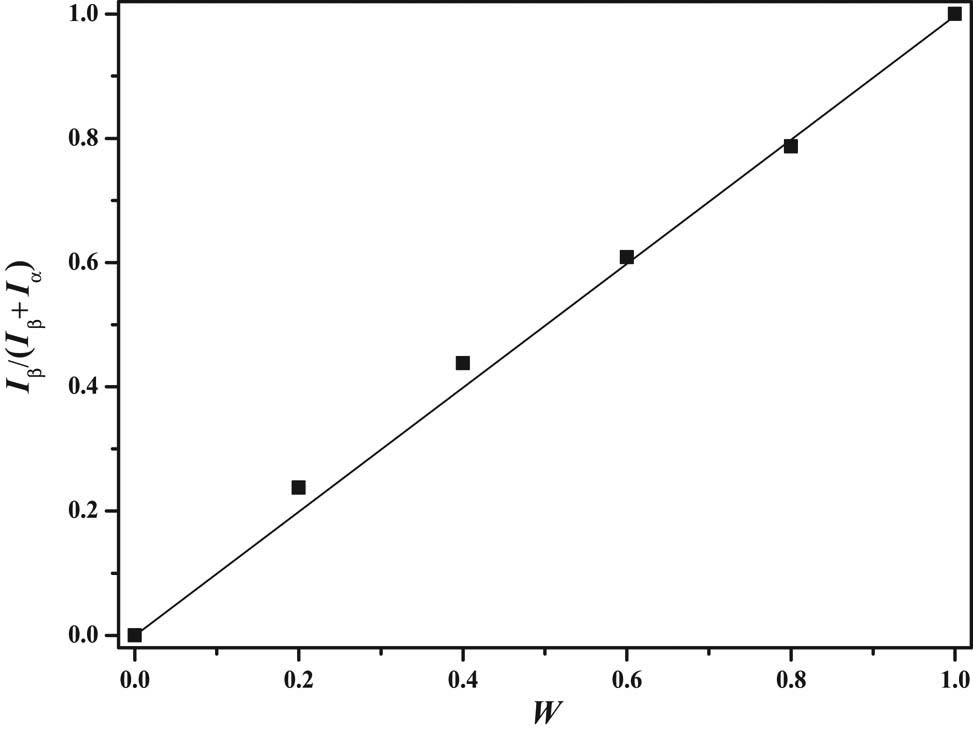
Plot of Iβ/(Iβ + Iα) as a function of W, the ratio of β-MoO3 to the sum of β-MoO3 and α-MoO3.
It is worth noting that another RIR method that measures the integrated peak intensity may have advantages and higher accuracy, but it is hard to accurately measure the integrated intensity and deal with interferences from other phases. In the present study, it was obvious that the strongest peak of β-MoO3 had some overlap with the small peak of α-MoO3, as shown in Figure 7(a), so it would be difficult to accurately measure the integrated intensity. If we adopted the multiple-peak separation method, it would waste a lot of time and have no practical application. Moreover, although the application of the Riveted quantitative analysis has demonstrated its excellent potential for complex samples, the time required for data processing is very long and does little to popularize its application. In contrast, the RIR method proposed in this study (measurement of the intensity of the strongest peaks of different phases) exhibits its own advantages: it is easy, quick, time-saving, and has high accuracy. Therefore, this method can be widely applied for the rough quantitative analysis of mixtures of β-MoO3 and α-MoO3. In the present study, both β-MoO3 and α-MoO3 had a small particle size (spherical or oval shaped, respectively), and so preferred orientation was eliminated. If the preferred orientation existed, for example, if peaks with a reflection of (0k0) for α-MoO3 were stronger, this method could not be applied.
3.3 Decomposition of β-MoO3
Before successfully preparing α-MoO3 by roasting β-MoO3 at 773 K in air, another method was attempted, that is, roasting β-MoO3 at 773 K in a highly pure Ar atmosphere (<5 ppm O2); however, pure α-MoO3 could not be obtained. The corresponding XRD pattern is shown in Figure 9. The roasted products were very complicated and included not only α-MoO3 but also MoO2 and Mo4O11. Here, Mo4O11 included two crystalline structures: orthorhombic Mo4O11 (o-Mo4O11) and monoclinic Mo4O11 (m-Mo4O11). In addition, the color of the roasted products was dark or gray, rather than white, which is shown in Figure 10.
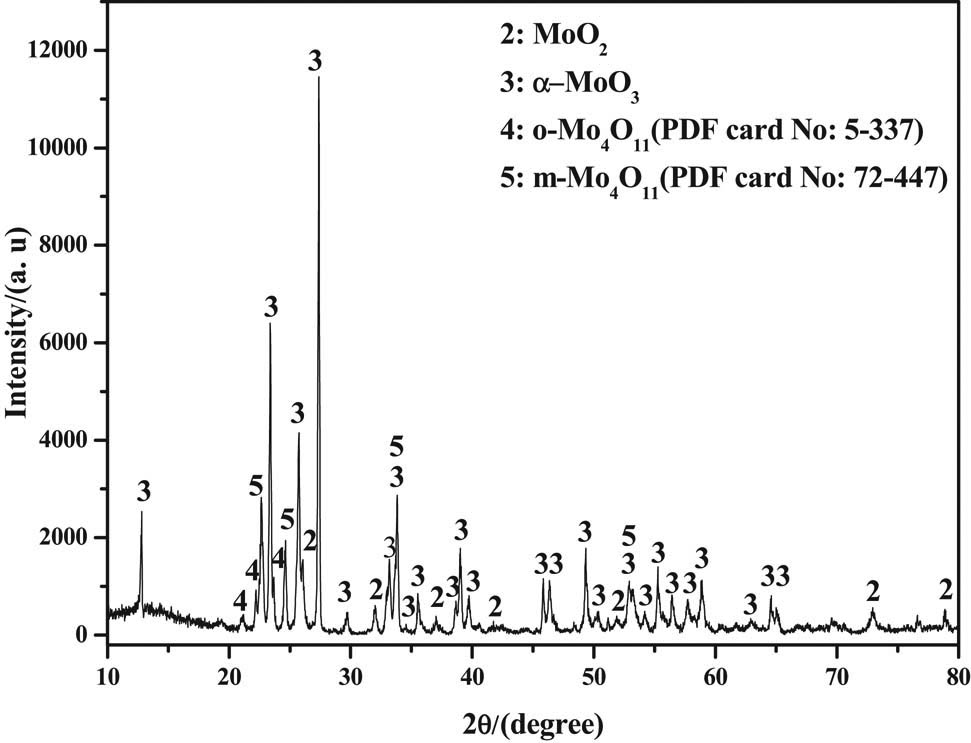
X-ray diffraction pattern of products obtained by roasting β-MoO3 at 773 K in highly pure argon atmosphere.
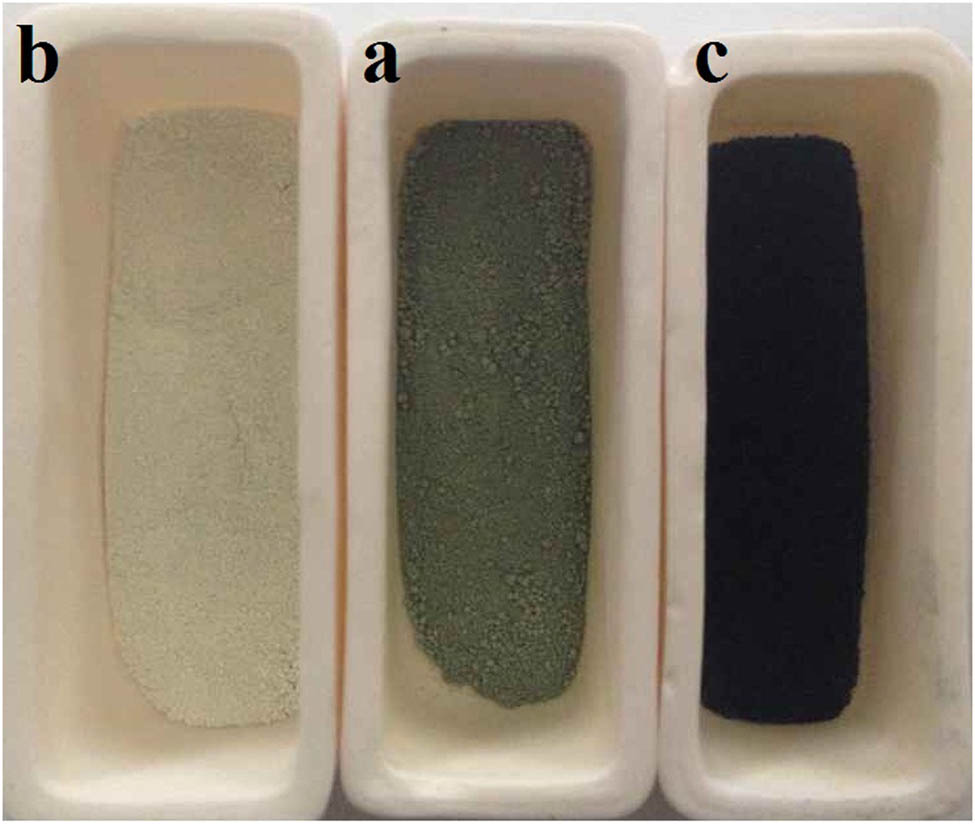
Color changes of roasted products obtained at 773 K: (a) raw β-MoO3; roasted under (b) air and (c) pure argon atmospheres.
It has been reported that raw green β-MoO3 may contain a number of oxygen vacancies [25,26,27]. When roasting β-MoO3 in air, the samples have enough opportunity to interact with O2. Maximum interaction between air and β-MoO3 is important to ensure that the following chemical equilibrium is shifted to the left [28]:
Oxygen exchange between the lattice and air has been investigated using isotope (18O2) labeling and Raman spectroscopy, which showed that gaseous O2 is able to incorporate into the oxygen-deficient β-MoO3 [29]. Therefore, perfect α-MoO3 can be prepared under air; however, when roasting β-MoO3 in the argon atmosphere, no O2 was provided to counter the oxygen-deficient β-MoO3, which led to shifting of the chemical equilibrium (2) to the right and the production of low-valent molybdenum oxides, such as MoO2 and Mo4O11. Once the oxygen defects were exhausted, the remaining components formed perfect α-MoO3. Therefore, different molybdenum–oxygen compounds can co-exist in the roasted products created under argon atmosphere conditions. The residue of α-MoO3 also indicated that α-MoO3 cannot be decomposed under the current experiment conditions, which was further supported by the data given in Figure 11. Figure 11 shows that whether using air or argon atmosphere, pure α-MoO3 was the only phase present in the final roasted products, that is, pure α-MoO3 cannot be decomposed, but β-MoO3 can be easily decomposed into MoO2 and Mo4O11. The corresponding decomposition correlations are summarized in Figure 12.
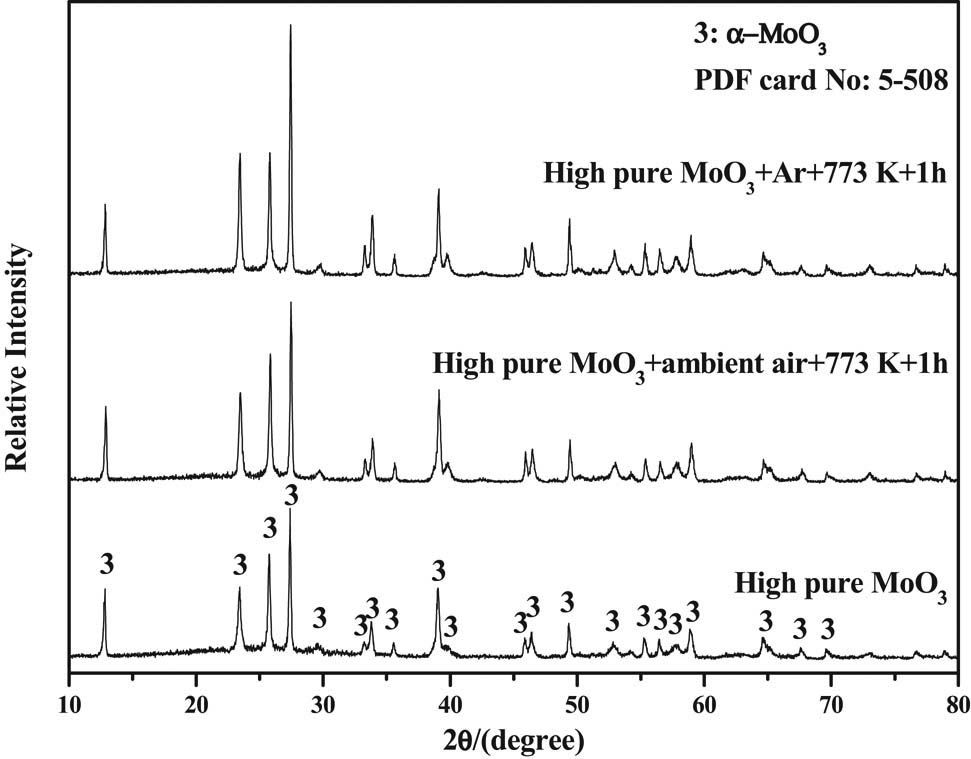
X-ray diffraction patterns of products obtained by roasting highly pure α-MoO3 in different atmospheres.
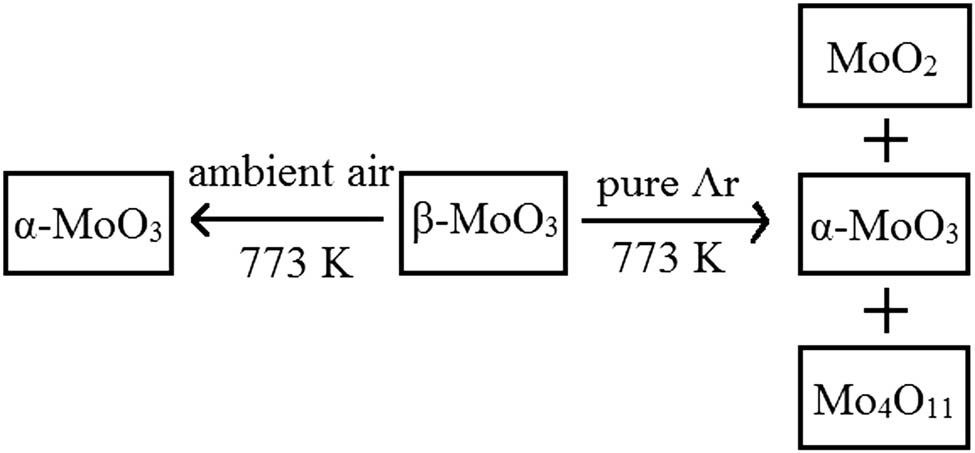
Schematic of the transformation of β-MoO3 under different conditions.
4 Conclusions
In the present study, the morphology evolution and the quantitative analysis of β-MoO3 and α-MoO3 were clarified. It was found that the morphology and color displayed obvious changes when β-MoO3 was transformed into α-MoO3. Spherical-shaped β-MoO3 had the tendency to form oval-shaped α-MoO3 when the heating temperature was around 773 K. XRD was used to quantitatively analyze the amount of β-MoO3 in mixtures of β-MoO3 and α-MoO3. It was found that the mass of β-MoO3 in the mixtures had a strong linear relationship with the intensities of the strongest peaks of β-MoO3 and α-MoO3. This provides an easy and convenient way to determine the amount of β-MoO3 in MoO3 mixtures. This approach may provide guidance for evaluation of the catalytic efficiency of MoO3 mixtures. In addition, the decomposition of β-MoO3 under argon gas atmosphere may result from the existing oxygen defects, which may contribute to the formation of MoO2 and Mo4O11.
Acknowledgments
The authors gratefully acknowledge the financial support from the National Natural Science Foundation of China (Grant Nos. 51474141 and 51874214), Guangdong Basic and Applied Basic Research Foundation (2019A1515110361), and Hubei Young Talents Development Project (1010048).
References
[1] Stephens, J., and D. Cruickshank. The crystal structure of CrO3. Acta Crystallographica Section B: Structural Science, Vol. 26, 1970, pp. 222–226.10.1107/S0567740870002182Search in Google Scholar
[2] Liu, D., W. Lei, J. Hao, D. Liu, B. Liu, X. Wang, et al. High-pressure Raman scattering and X-ray diffraction of phase transitions in MoO3. Journal of Applied Physics, Vol. 105, 2009, id. 023513.10.1063/1.3056049Search in Google Scholar
[3] Enjalbert, R., and J. Galy. A refinement of the structure of V2O5. Acta Crystallographica Section C, Vol. 42, 1986, pp. 1467–1469.10.1107/S0108270186091825Search in Google Scholar
[4] Zhao, J., P. Ma, and J. Wang. Synthesis and structural characterization of a novel three-dimensional molybdenum-oxygen framework constructed from Mo3O9 units. Chemistry Letters, Vol. 38, 2009, pp. 694–695.10.1246/cl.2009.694Search in Google Scholar
[5] Farneth, W., E. Mccarron, A. Sleight, and R. Staley. A comparison of the surface chemistry of two polymorphic forms of molybdenum trioxide. Langmuir, Vol. 3, 1987, pp. 217–223.10.1021/la00074a013Search in Google Scholar
[6] Bando, Y., Y. Kato, and T. Takada. Crystal Growth of Molybdenum Oxides by Chemical Transport. Bulletin of the Institute for Chemical Research, Kyoto University, Vol. 54, 1976, pp. 330–334.Search in Google Scholar
[7] Navas, I., R. Vinodkumar, K. Lethy, A. Detty, V. Ganesan, V. Sathe, et al. Growth and characterization of molybdenum oxide nanorods by RF magnetron sputtering and subsequent annealing. Journal of Physics D: Applied Physics, Vol. 42, 2009, id. 175305.10.1088/0022-3727/42/17/175305Search in Google Scholar
[8] Phuc, N. H. H., H. Ohkita, T. Mizushima, and N. Kakuta. Simple method to prepare new structure of metastable molybdenum(vi) oxide. Materials Letters, Vol. 76, 2012, pp. 173–176.10.1016/j.matlet.2012.02.108Search in Google Scholar
[9] Mccarron, E. β-MoO3: a metastable analogue of WO3. Journal of the Chemical Society, Chemical Communications, Vol. 4, 1986, pp. 336–338.10.1039/C39860000336Search in Google Scholar
[10] Mizushima, T., Y. Moriya, N. H. H. Phuc, H. Ohkita, and N. Kakuta. Soft chemical transformation of α-MoO3 to β-MoO3 as a catalyst for vapor-phase oxidation of methanol. Catalysis Communications, Vol. 13, 2011, pp. 10–13.10.1016/j.catcom.2011.06.012Search in Google Scholar
[11] Mizushima, T., K. Fukushima, T. M. Huong, H. Ohkita, and N. Kakuta. Synthesis of BETA-MoO3 by simple evaporation of molybdic acid solution containing nitric acid. Chemical Letters, Vol. 34, 2005, pp. 986–987.10.1246/cl.2005.986Search in Google Scholar
[12] Parise, J., E. Mccarron, R. Von Dreele, and J. Goldstone. β-MoO3 produced from a novel freeze drying route. Journal of Solid State Chemistry, Vol. 93, 1991, pp. 193–201.10.1016/0022-4596(91)90288-SSearch in Google Scholar
[13] Mcevoy, T. M., K. J. Stevenson, J. T. Hupp, and X. Dang. Electrochemical preparation of molybdenum trioxide thin films: effect of sintering on electrochromic and electroinsertion properties. Langmuir, Vol. 19, 2003, pp. 4316–4326.10.1021/la027020uSearch in Google Scholar
[14] Ding, Q., H. Huang, J. Duan, J. Gong, S. Yang, X. Zhao, et al. Molybdenum trioxide nanostructures prepared by thermal oxidization of molybdenum. Journal of Crystal Growth, Vol. 294, 2006, pp. 304–380.10.1016/j.jcrysgro.2006.07.004Search in Google Scholar
[15] Wang, L., G. H. Zhang, K. C. Chou. Mechanism and kinetic study of hydrogen reduction of ultra-fine spherical MoO3 to MoO2. International Journal of Refractory Metals and Hard Materials, Vol. 54, 2016, pp. 342–350.10.1016/j.ijrmhm.2015.09.003Search in Google Scholar
[16] Yang, W. Q., Z. R. Wei, M. Gao, Y. Chen, J. Xu, C. L. Chen, et al. Fabrication and field emission properties of needle-shaped MoO3 nanobelts. Journal of Alloys and Compounds, Vol. 576, 2013, pp. 332–335.10.1016/j.jallcom.2013.05.221Search in Google Scholar
[17] Pawloski, G. A. Quantitative determination of mineral content of geological samples by X-ray diffraction. American Mineralogist, Vol. 70, 1985, pp. 663–667.Search in Google Scholar
[18] Chung, F. H. Quantitative interpretation of X-ray diffraction patterns of mixtures. I. Matrix-flushing method for quantitative multicomponent analysis. Journal of Applied Crystallography, Vol. 7, 1974, pp. 519–525.10.1107/S0021889874010375Search in Google Scholar
[19] Hillier, S. Accurate quantitative analysis of clay and other minerals in sandstones by XRD: comparison of a Rietveld and a reference intensity ratio (RIR) method and the importance of sample preparation. Clay Minerals, Vol. 35, 2000, pp. 291–302.10.1180/000985500546666Search in Google Scholar
[20] Vaverka, J., and K. Sakurai. Quantitative determination of free lime amount in steelmaking slag by X-ray diffraction. ISIJ International, Vol. 54, 2014, pp. 1334–1337.10.2355/isijinternational.54.1334Search in Google Scholar
[21] Shu, Q. F., J. Wu, and K. C. Chou. Kinetics study on reduction of CaWO4 by Si from 1423 K to 1523 K. High Temperature Materials and Processes, Vol. 34, 2015, pp. 805–811.10.1515/htmp-2014-0161Search in Google Scholar
[22] Wang, L., G. H. Zhang, Y. J. Sun, X. W. Zhou, and K. C. Chou. Preparation of ultrafine β-MoO3 from industrial grade MoO3 powder by the method of sublimation. Journal of Physical Chemistry C, Vol. 120, 2016, pp. 19821–19829.10.1021/acs.jpcc.6b05982Search in Google Scholar
[23] Wang, L., G. H. Zhang, Z. L. Xue, and C. M. Song. Shape-controlled preparation of Mo powder by temperature-programmed reduction of MoO3 by NH3. Chemistry Letters, Vol. 48, 2019, pp. 475–478.10.1246/cl.190001Search in Google Scholar
[24] Sayede, A., T. Amriou, M. Pernisek, B. Khelifa, and C. Mathieu. An ab initio LAPW study of the α and β phases of bulk molybdenum trioxide, MoO3. Chemical Physics, Vol. 316, 2005, pp. 72–82.10.1016/j.chemphys.2005.04.036Search in Google Scholar
[25] Julien, C., A. Khelfa, O. Hussain, and G. Nazri. Synthesis and characterization of flash-evaporated MoO3 thin films. Journal of Crystal Growth, Vol. 156, 1995, pp. 235–244.10.1016/0022-0248(95)00269-3Search in Google Scholar
[26] Simmons, J., and G. Nadkarni. Alternating current electrical properties of evaporated molybdenum oxide films. Journal of Vacuum Science and Technology, Vol. 6, 1969, pp. 12–17.10.1116/1.1492614Search in Google Scholar
[27] Varlec, A., D. Arčon, S. D. Škapin, M. Remškar. Oxygen deficiency in MoO3 polycrystalline nanowires and nanotubes. Materials Chemistry and Physics, Vol. 170, 2016, pp. 154–161.10.1016/j.matchemphys.2015.12.033Search in Google Scholar
[28] Zeng, H., C. Sheu, and H. Hia. Kinetic study of vapor-phase preparation of orthorhombic molybdenum trioxide. Chemistry of Materials, Vol. 10, 1998, pp. 974–979.10.1021/cm970345pSearch in Google Scholar
[29] Mestl, G., P. Ruiz, B. Delmon, and H. Knozinger. Oxygen-exchange properties of MoO3: an in situ Raman spectroscopy study. The Journal of Physical Chemistry, Vol. 98, 1994, pp. 11269–11275.10.1021/j100095a007Search in Google Scholar
© 2020 Lu Wang et al., published by De Gruyter
This work is licensed under the Creative Commons Attribution 4.0 International License.
Articles in the same Issue
- Research Article
- Electrochemical reduction mechanism of several oxides of refractory metals in FClNaKmelts
- Study on the Appropriate Production Parameters of a Gas-injection Blast Furnace
- Microstructure, phase composition and oxidation behavior of porous Ti-Si-Mo intermetallic compounds fabricated by reactive synthesis
- Significant Influence of Welding Heat Input on the Microstructural Characteristics and Mechanical Properties of the Simulated CGHAZ in High Nitrogen V-Alloyed Steel
- Preparation of WC-TiC-Ni3Al-CaF2 functionally graded self-lubricating tool material by microwave sintering and its cutting performance
- Research on Electromagnetic Sensitivity Properties of Sodium Chloride during Microwave Heating
- Effect of deformation temperature on mechanical properties and microstructure of TWIP steel for expansion tube
- Effect of Cooling Rate on Crystallization Behavior of CaO-SiO2-MgO-Cr2O3 Based Slag
- Effects of metallurgical factors on reticular crack formations in Nb-bearing pipeline steel
- Investigation on microstructure and its transformation mechanisms of B2O3-SiO2-Al2O3-CaO brazing flux system
- Energy Conservation and CO2 Abatement Potential of a Gas-injection Blast Furnace
- Experimental validation of the reaction mechanism models of dechlorination and [Zn] reclaiming in the roasting steelmaking zinc-rich dust process
- Effect of substituting fine rutile of the flux with nano TiO2 on the improvement of mass transfer efficiency and the reduction of welding fumes in the stainless steel SMAW electrode
- Microstructure evolution and mechanical properties of Hastelloy X alloy produced by Selective Laser Melting
- Study on the structure activity relationship of the crystal MOF-5 synthesis, thermal stability and N2 adsorption property
- Laser pressure welding of Al-Li alloy 2198: effect of welding parameters on fusion zone characteristics associated with mechanical properties
- Microstructural evolution during high-temperature tensile creep at 1,500°C of a MoSiBTiC alloy
- Effects of different deoxidization methods on high-temperature physical properties of high-strength low-alloy steels
- Solidification pathways and phase equilibria in the Mo–Ti–C ternary system
- Influence of normalizing and tempering temperatures on the creep properties of P92 steel
- Effect of temperature on matrix multicracking evolution of C/SiC fiber-reinforced ceramic-matrix composites
- Improving mechanical properties of ZK60 magnesium alloy by cryogenic treatment before hot extrusion
- Temperature-dependent proportional limit stress of SiC/SiC fiber-reinforced ceramic-matrix composites
- Effect of 2CaO·SiO2 particles addition on dephosphorization behavior
- Influence of processing parameters on slab stickers during continuous casting
- Influence of Al deoxidation on the formation of acicular ferrite in steel containing La
- The effects of β-Si3N4 on the formation and oxidation of β-SiAlON
- Sulphur and vanadium-induced high-temperature corrosion behaviour of different regions of SMAW weldment in ASTM SA 210 GrA1 boiler tube steel
- Structural evidence of complex formation in liquid Pb–Te alloys
- Microstructure evolution of roll core during the preparation of composite roll by electroslag remelting cladding technology
- Improvement of toughness and hardness in BR1500HS steel by ultrafine martensite
- Influence mechanism of pulse frequency on the corrosion resistance of Cu–Zn binary alloy
- An interpretation on the thermodynamic properties of liquid Pb–Te alloys
- Dynamic continuous cooling transformation, microstructure and mechanical properties of medium-carbon carbide-free bainitic steel
- Influence of electrode tip diameter on metallurgical and mechanical aspects of spot welded duplex stainless steel
- Effect of multi-pass deformation on microstructure evolution of spark plasma sintered TC4 titanium alloy
- Corrosion behaviors of 316 stainless steel and Inconel 625 alloy in chloride molten salts for solar energy storage
- Determination of chromium valence state in the CaO–SiO2–FeO–MgO–CrOx system by X-ray photoelectron spectroscopy
- Electric discharge method of synthesis of carbon and metal–carbon nanomaterials
- Effect of high-frequency electromagnetic field on microstructure of mold flux
- Effect of hydrothermal coupling on energy evolution, damage, and microscopic characteristics of sandstone
- Effect of radiative heat loss on thermal diffusivity evaluated using normalized logarithmic method in laser flash technique
- Kinetics of iron removal from quartz under ultrasound-assisted leaching
- Oxidizability characterization of slag system on the thermodynamic model of superalloy desulfurization
- Influence of polyvinyl alcohol–glutaraldehyde on properties of thermal insulation pipe from blast furnace slag fiber
- Evolution of nonmetallic inclusions in pipeline steel during LF and VD refining process
- Development and experimental research of a low-thermal asphalt material for grouting leakage blocking
- A downscaling cold model for solid flow behaviour in a top gas recycling-oxygen blast furnace
- Microstructure evolution of TC4 powder by spark plasma sintering after hot deformation
- The effect of M (M = Ce, Zr, Ce–Zr) on rolling microstructure and mechanical properties of FH40
- Phase evolution and oxidation characteristics of the Nd–Fe–B and Ce–Fe–B magnet scrap powder during the roasting process
- Assessment of impact mechanical behaviors of rock-like materials heated at 1,000°C
- Effects of solution and aging treatment parameters on the microstructure evolution of Ti–10V–2Fe–3Al alloy
- Effect of adding yttrium on precipitation behaviors of inclusions in E690 ultra high strength offshore platform steel
- Dephosphorization of hot metal using rare earth oxide-containing slags
- Kinetic analysis of CO2 gasification of biochar and anthracite based on integral isoconversional nonlinear method
- Optimization of heat treatment of glass-ceramics made from blast furnace slag
- Study on microstructure and mechanical properties of P92 steel after high-temperature long-term aging at 650°C
- Effects of rotational speed on the Al0.3CoCrCu0.3FeNi high-entropy alloy by friction stir welding
- The investigation on the middle period dephosphorization in 70t converter
- Effect of cerium on the initiation of pitting corrosion of 444-type heat-resistant ferritic stainless steel
- Effects of quenching and partitioning (Q&P) technology on microstructure and mechanical properties of VC particulate reinforced wear-resistant alloy
- Study on the erosion of Mo/ZrO2 alloys in glass melting process
- Effect of Nb addition on the solidification structure of Fe–Mn–C–Al twin-induced plasticity steel
- Damage accumulation and lifetime prediction of fiber-reinforced ceramic-matrix composites under thermomechanical fatigue loading
- Morphology evolution and quantitative analysis of β-MoO3 and α-MoO3
- Microstructure of metatitanic acid and its transformation to rutile titanium dioxide
- Numerical simulation of nickel-based alloys’ welding transient stress using various cooling techniques
- The local structure around Ge atoms in Ge-doped magnetite thin films
- Friction stir lap welding thin aluminum alloy sheets
- Review Article
- A review of end-point carbon prediction for BOF steelmaking process
Articles in the same Issue
- Research Article
- Electrochemical reduction mechanism of several oxides of refractory metals in FClNaKmelts
- Study on the Appropriate Production Parameters of a Gas-injection Blast Furnace
- Microstructure, phase composition and oxidation behavior of porous Ti-Si-Mo intermetallic compounds fabricated by reactive synthesis
- Significant Influence of Welding Heat Input on the Microstructural Characteristics and Mechanical Properties of the Simulated CGHAZ in High Nitrogen V-Alloyed Steel
- Preparation of WC-TiC-Ni3Al-CaF2 functionally graded self-lubricating tool material by microwave sintering and its cutting performance
- Research on Electromagnetic Sensitivity Properties of Sodium Chloride during Microwave Heating
- Effect of deformation temperature on mechanical properties and microstructure of TWIP steel for expansion tube
- Effect of Cooling Rate on Crystallization Behavior of CaO-SiO2-MgO-Cr2O3 Based Slag
- Effects of metallurgical factors on reticular crack formations in Nb-bearing pipeline steel
- Investigation on microstructure and its transformation mechanisms of B2O3-SiO2-Al2O3-CaO brazing flux system
- Energy Conservation and CO2 Abatement Potential of a Gas-injection Blast Furnace
- Experimental validation of the reaction mechanism models of dechlorination and [Zn] reclaiming in the roasting steelmaking zinc-rich dust process
- Effect of substituting fine rutile of the flux with nano TiO2 on the improvement of mass transfer efficiency and the reduction of welding fumes in the stainless steel SMAW electrode
- Microstructure evolution and mechanical properties of Hastelloy X alloy produced by Selective Laser Melting
- Study on the structure activity relationship of the crystal MOF-5 synthesis, thermal stability and N2 adsorption property
- Laser pressure welding of Al-Li alloy 2198: effect of welding parameters on fusion zone characteristics associated with mechanical properties
- Microstructural evolution during high-temperature tensile creep at 1,500°C of a MoSiBTiC alloy
- Effects of different deoxidization methods on high-temperature physical properties of high-strength low-alloy steels
- Solidification pathways and phase equilibria in the Mo–Ti–C ternary system
- Influence of normalizing and tempering temperatures on the creep properties of P92 steel
- Effect of temperature on matrix multicracking evolution of C/SiC fiber-reinforced ceramic-matrix composites
- Improving mechanical properties of ZK60 magnesium alloy by cryogenic treatment before hot extrusion
- Temperature-dependent proportional limit stress of SiC/SiC fiber-reinforced ceramic-matrix composites
- Effect of 2CaO·SiO2 particles addition on dephosphorization behavior
- Influence of processing parameters on slab stickers during continuous casting
- Influence of Al deoxidation on the formation of acicular ferrite in steel containing La
- The effects of β-Si3N4 on the formation and oxidation of β-SiAlON
- Sulphur and vanadium-induced high-temperature corrosion behaviour of different regions of SMAW weldment in ASTM SA 210 GrA1 boiler tube steel
- Structural evidence of complex formation in liquid Pb–Te alloys
- Microstructure evolution of roll core during the preparation of composite roll by electroslag remelting cladding technology
- Improvement of toughness and hardness in BR1500HS steel by ultrafine martensite
- Influence mechanism of pulse frequency on the corrosion resistance of Cu–Zn binary alloy
- An interpretation on the thermodynamic properties of liquid Pb–Te alloys
- Dynamic continuous cooling transformation, microstructure and mechanical properties of medium-carbon carbide-free bainitic steel
- Influence of electrode tip diameter on metallurgical and mechanical aspects of spot welded duplex stainless steel
- Effect of multi-pass deformation on microstructure evolution of spark plasma sintered TC4 titanium alloy
- Corrosion behaviors of 316 stainless steel and Inconel 625 alloy in chloride molten salts for solar energy storage
- Determination of chromium valence state in the CaO–SiO2–FeO–MgO–CrOx system by X-ray photoelectron spectroscopy
- Electric discharge method of synthesis of carbon and metal–carbon nanomaterials
- Effect of high-frequency electromagnetic field on microstructure of mold flux
- Effect of hydrothermal coupling on energy evolution, damage, and microscopic characteristics of sandstone
- Effect of radiative heat loss on thermal diffusivity evaluated using normalized logarithmic method in laser flash technique
- Kinetics of iron removal from quartz under ultrasound-assisted leaching
- Oxidizability characterization of slag system on the thermodynamic model of superalloy desulfurization
- Influence of polyvinyl alcohol–glutaraldehyde on properties of thermal insulation pipe from blast furnace slag fiber
- Evolution of nonmetallic inclusions in pipeline steel during LF and VD refining process
- Development and experimental research of a low-thermal asphalt material for grouting leakage blocking
- A downscaling cold model for solid flow behaviour in a top gas recycling-oxygen blast furnace
- Microstructure evolution of TC4 powder by spark plasma sintering after hot deformation
- The effect of M (M = Ce, Zr, Ce–Zr) on rolling microstructure and mechanical properties of FH40
- Phase evolution and oxidation characteristics of the Nd–Fe–B and Ce–Fe–B magnet scrap powder during the roasting process
- Assessment of impact mechanical behaviors of rock-like materials heated at 1,000°C
- Effects of solution and aging treatment parameters on the microstructure evolution of Ti–10V–2Fe–3Al alloy
- Effect of adding yttrium on precipitation behaviors of inclusions in E690 ultra high strength offshore platform steel
- Dephosphorization of hot metal using rare earth oxide-containing slags
- Kinetic analysis of CO2 gasification of biochar and anthracite based on integral isoconversional nonlinear method
- Optimization of heat treatment of glass-ceramics made from blast furnace slag
- Study on microstructure and mechanical properties of P92 steel after high-temperature long-term aging at 650°C
- Effects of rotational speed on the Al0.3CoCrCu0.3FeNi high-entropy alloy by friction stir welding
- The investigation on the middle period dephosphorization in 70t converter
- Effect of cerium on the initiation of pitting corrosion of 444-type heat-resistant ferritic stainless steel
- Effects of quenching and partitioning (Q&P) technology on microstructure and mechanical properties of VC particulate reinforced wear-resistant alloy
- Study on the erosion of Mo/ZrO2 alloys in glass melting process
- Effect of Nb addition on the solidification structure of Fe–Mn–C–Al twin-induced plasticity steel
- Damage accumulation and lifetime prediction of fiber-reinforced ceramic-matrix composites under thermomechanical fatigue loading
- Morphology evolution and quantitative analysis of β-MoO3 and α-MoO3
- Microstructure of metatitanic acid and its transformation to rutile titanium dioxide
- Numerical simulation of nickel-based alloys’ welding transient stress using various cooling techniques
- The local structure around Ge atoms in Ge-doped magnetite thin films
- Friction stir lap welding thin aluminum alloy sheets
- Review Article
- A review of end-point carbon prediction for BOF steelmaking process

